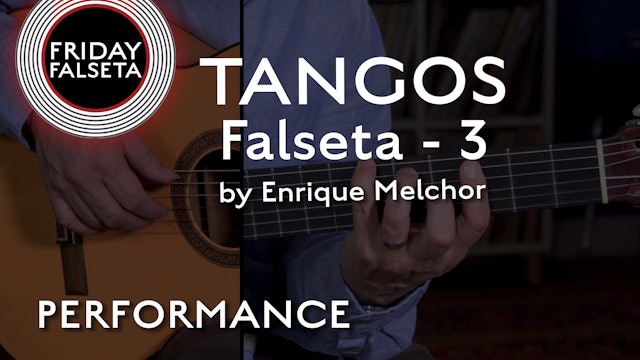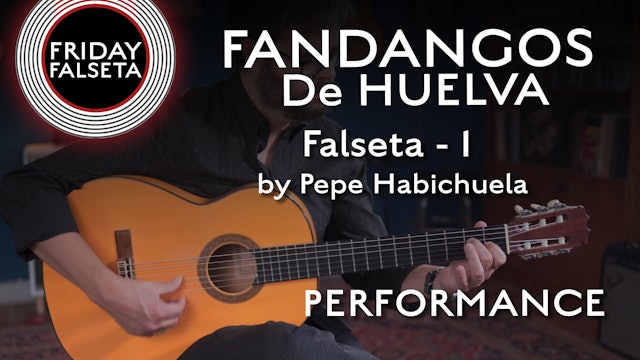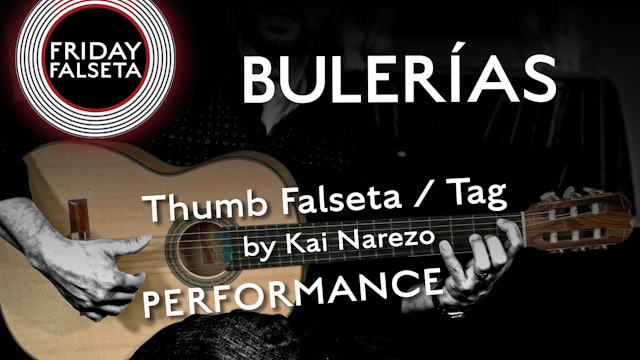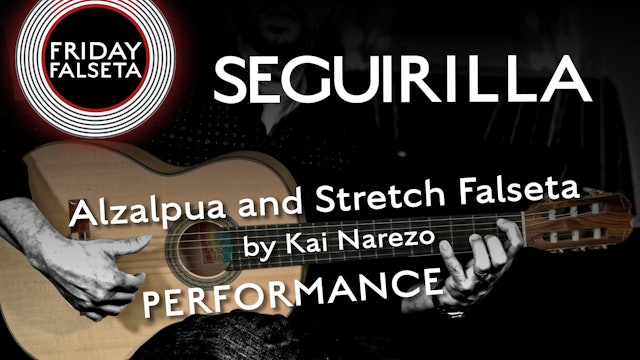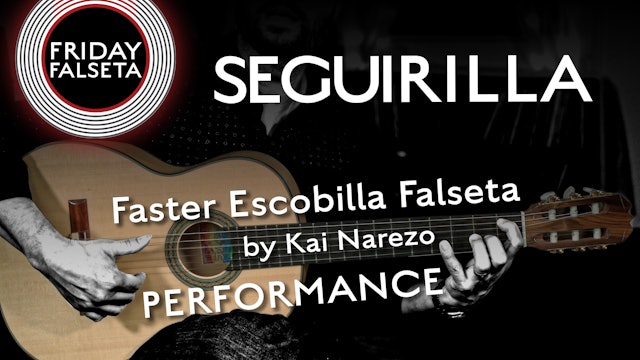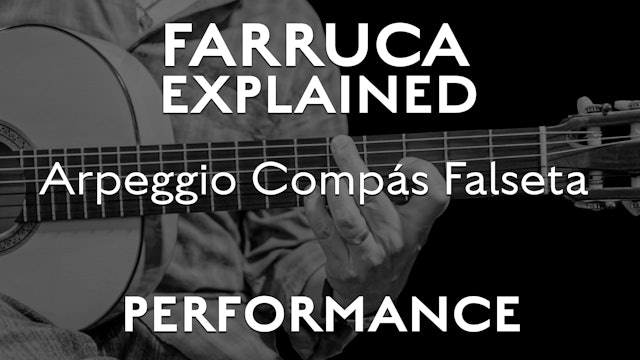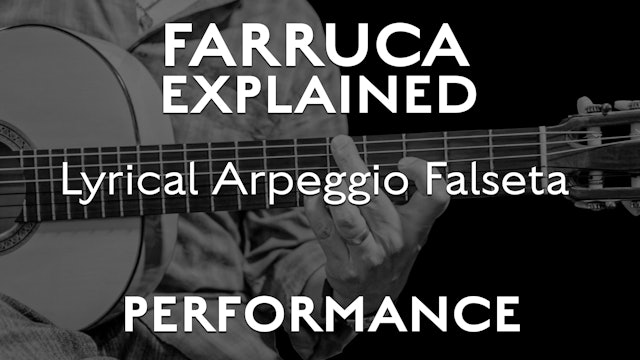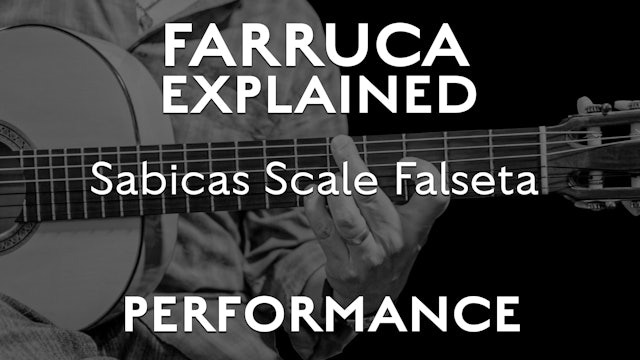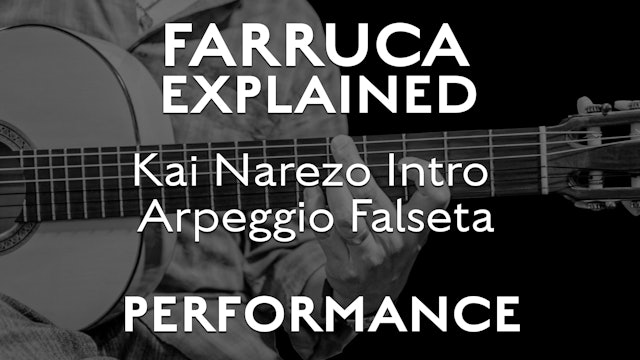-
Friday Falseta - Tangos - Enrique Melchor #3 - PERFORMANCE
Episode 1
An advanced Tangos Falseta by Enrique Melchor that features a bit each of Arpeggio, Picado and Alzapua.
-
Friday Falseta - Fandangos de Huelva - Kai Narezo Falseta #1 - PERFORMANCE
Episode 2
An intermediate level Fandangos de Huelva falseta that features a bit of syncopation and a few little bursts of arpeggio. Works great as an intro, or you can use it anywhere in your Fandangos de Huelva.
-
Friday Falseta - Fandangos de Huelva - Pepe Habichuela Falseta - PERFORMANCE
Episode 3
A classic intermediate/advanced Fandangos de Huelva falseta by Pepe Habichuela. It features a lot of scales, but since the scales are phrased in triplets and not in 16th notes it’s not quite as technically challenging as it could be and actually quite playable.
-
Friday Falseta - Solea - Sabicas Falseta #1 - PERFORMANCE
Episode 4
This Sabicas Soleá falseta will not only work both hands but will also really work the coordination between the two hands. Plus it’s one of the all-time great Soleá falsetas that works at any tempo. Traditional definitely doesn’t always mean easy!
-
Friday Falseta - Solea - Ramon Montoya Falseta #1 - PERFORMANCE
Episode 5
This classic Soleá falseta by the great Ramon Montoya starts out quite elegantly and then ends with a bang. It’s also a fantastic left-hand workout, and it has a little quirk, in that it has an “extra” six beats (don’t worry, we explain why and also how to remedy the situation if needed).
-
Friday Falseta - Tangos Por Arriba Falseta by Kai Narezo - PERFORMANCE
Episode 6
Tangos can be played in many keys, and after Por Medio, the most common other key is Por Arriba (E Phrygian), the key that Tangos de Granada is often played in. Here’s a fun falseta that can be played as written, but also has a lot of moving parts that you can use as shorter falsetas or simply to...
-
Friday Falseta - Alegrias Slur Falseta by Kai Narezo - PERFORMANCE
Episode 7
Here’s a short but tricky Alegrias falseta that will really work both your left hand and your compás. In addition to some 16th note slurs that include a lot of pinky action, the phrases don’t quite resolve where we would expect them to. Once you’ve learned the notes, make sure you’re really comfo...
-
Friday Falseta - Guajira Falseta #2 by Kai Narezo - PERFORMANCE
Episode 8
Here’s an advanced Guajiras falseta that works at both faster and slower tempos and involves quite a few little scale bursts for you to work on. Could also work as a somewhat rubato intro at a slower speed.
-
Friday Falseta - Colombiana Falseta #1 by Kai Narezo - PERFORMANCE
Episode 9
This intermediate/advanced Colombianas falseta follows a more or less traditional chord progression you’ll want to be familiar with when playing Colombianas. You can use our Tangos compás loops to practice this one: https://learn.flamencoexplained.com/compas-loops/season:5
-
Friday Falseta - Tangos Traditional Line Cliche by Kai Narezo - PERFORMANCE
Episode 10
A line cliche is when one note within a chord moves by half-steps. The second half of this falseta features a line cliche on the D minor chord where the bass note moves down from the note D on the fifth string. This is a traditional figure that you’ll probably recognize more once you learn to pla...
-
Friday Falseta - Bulerias Thumb Falseta/Tag by Kai Narezo - PERFORMANCE
Episode 11
A fun falseta that can also be used a tag for something else, this one starts just before beat 12 and features quite a bit of thumb technique as well as some precise left-hand movement.
-
Friday Falseta - Seguirilla Alzapua & Stretch by Kai Narezo - PERFORMANCE
Episode 12
Here’s an uptempo Seguirillas falseta you might want to practice with a capo, given the left-hand stretches involved. In addition to the stretches it’s a good alzapua workout, so make sure you’re relaxed as you learn and practice this one. And try to hear the sextuplets in the alzapua before you ...
-
Friday Falseta - Bulerias Falseta Por Fiesta by Kai Narezo - PERFORMANCE
Episode 13
I say this one is good Por Fiesta because it’s all thumb so you can play it loud and, once learned, should be playable at quick speeds. Watch out for those pickup notes at the beginning, though, as it starts just after beat 10.
-
Friday Falseta - Tangos Alzapua Workout #2 by Kai Narezo - PERFORMANCE
Episode 14
This Tangos falseta features a very common alzapua burst and quite a bit of left-hand / right-hand coordination to make it sound its best. Also, watch out for the rhythm change from 16th to 8th notes.
-
Friday Falseta - Seguirilla Faster Escobilla Falseta by Kai Narezo - PERFORMANCE
Episode 15
This Seguirilla falseta works best at faster speeds, making it useful for Escobillas or any other time you need a fast-tempo falseta. You’ll want to watch out for the compás, and also for the left hand, which needs to leave space for adjacent open strings to ring. As always, simple doesn’t mean e...
-
Tangos Explained - Thumb Tomatito Falseta - Performance
Episode 16
One of my favorite Tomatito falsetas por Tangos, this one features thumb and alzapua techniques, along with some big left hand stretches. Most of it is ‘simple’ but not easy, especially to get it to sound as powerful as Tomatito does when he plays it. And the little alzapua bit at the end is neit...
-
Farruca Explained - Arpeggio/ Compás Falseta - PERFORMANCE
Episode 17
A traditional arpeggio falseta made up of elements that we can also use in constructing compás. We've run into most of this material earlier in the Compás Embellishments video.
-
Farruca Explained - Lyrical Arpeggio Falseta - PERFORMANCE
Episode 18
Performance of a really lovely arpeggio falseta that works as an intro or as a lyrical interlude for dance or solo guitar.
-
Farruca Explained - Sabicas Scale Falseta - PERFORMANCE
Episode 19
A great all-scale falseta by Sabicas that happens to be one of the best-known Farruca falsetas around. Great Technical workout, too!
-
Farruca Explained - Thumb Falseta with Scale - PERFORMANCE
Episode 20
A nice falseta that features thumb with slurs at the beginning and ends with a long scale run.
-
Farruca Explained - Kai Narezo Intro Arpeggio Falseta - PERFORMANCE
Episode 21
Performance of one of Kai's falsetas that features some lovely harmony with arpeggios and ends with some scale bursts.
-
Seguirillas Explained - Quique Paredes Falseta - PERFORMANCE
Episode 22
This one employs a lot of bouncy thumb technique and can drive pretty hard, though you can also play it more lyrically.
-
Seguirillas Explained - Manolo Franco Falseta - PERFORMANCE
Episode 23
This is a great Seguirilla falseta that features a common polyrhythm. It's mostly thumb, with a great thumb/alzapua remate at the end.
-
Seguirillas Explained - Kai Narezo Falseta #2- PERFORMANCE
Episode 24
This one starts out more on the lyrical side, but ends with a couple of more driving compases.



